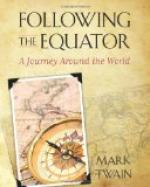I know that I ought to do with the Taj as I was obliged to do with Niagara—see it fifteen times, and let my mind gradually get rid of the Taj built in it by its describers, by help of my imagination, and substitute for it the Taj of fact. It would be noble and fine, then, and a marvel; not the marvel which it replaced, but still a marvel, and fine enough. I am a careless reader, I suppose—an impressionist reader; an impressionist reader of what is not an impressionist picture; a reader who overlooks the informing details or masses their sum improperly, and gets only a large splashy, general effect—an effect which is not correct, and which is not warranted by the particulars placed before me particulars which I did not examine, and whose meanings I did not cautiously and carefully estimate. It is an effect which is some thirty-five or forty times finer than the reality, and is therefore a great deal better and more valuable than the reality; and so, I ought never to hunt up the reality, but stay miles away from it, and thus preserve undamaged my own private mighty Niagara tumbling out of the vault of heaven, and my own ineffable Taj, built of tinted mists upon jeweled arches of rainbows supported by colonnades of moonlight. It is a mistake for a person with an unregulated imagination to go and look at an illustrious world’s wonder.
I suppose that many, many years ago I gathered the idea that the Taj’s place in the achievements of man was exactly the place of the ice-storm in the achievements of Nature; that the Taj represented man’s supremest possibility in the creation of grace and beauty and exquisiteness and splendor, just as the ice-storm represents Nature’s supremest possibility in the combination of those same qualities. I do not know how long ago that idea was bred in me, but I know that I cannot remember back to a time when the thought of either of these symbols of gracious and unapproachable perfection did not at once suggest the other. If I thought of the ice-storm, the Taj rose before me divinely beautiful; if I thought of the Taj, with its encrustings and inlayings of jewels, the vision of the ice-storm rose. And so, to me, all these years, the Taj has had no rival among the temples and palaces of men, none that even remotely approached it it was man’s architectural ice-storm.
Here in London the other night I was talking with some Scotch and English friends, and I mentioned the ice-storm, using it as a figure—a figure which failed, for none of them had heard of the ice-storm. One gentleman, who was very familiar with American literature, said he had never seen it mentioned in any book. That is strange. And I, myself, was not able to say that I had seen it mentioned in a book; and yet the autumn foliage, with all other American scenery, has received full and competent attention.




